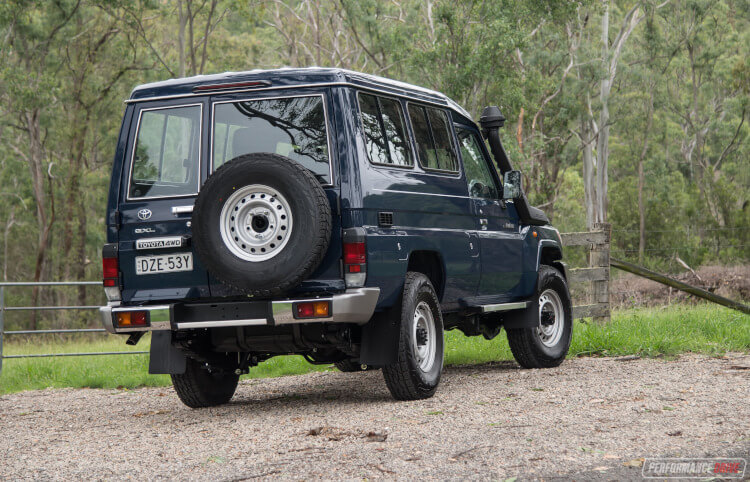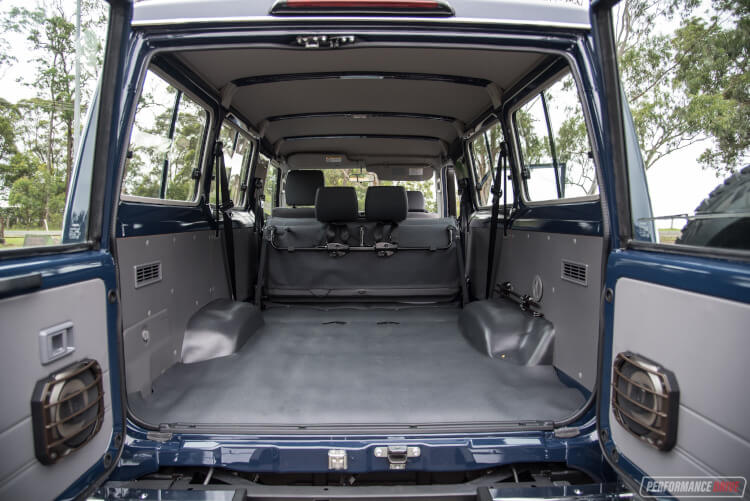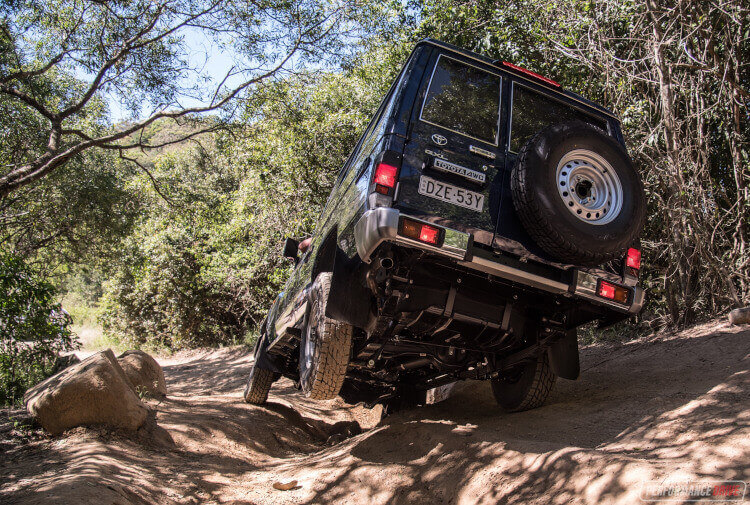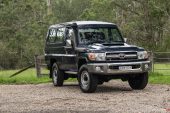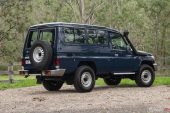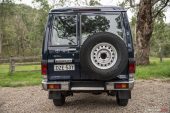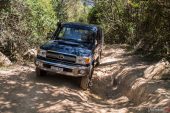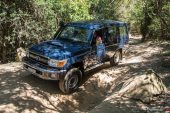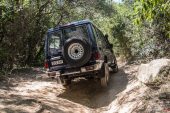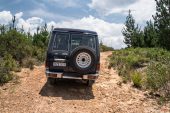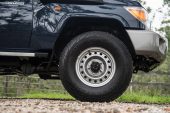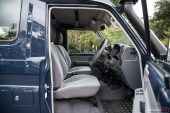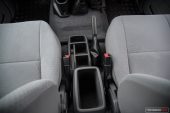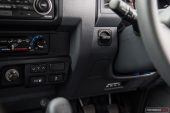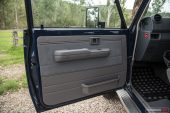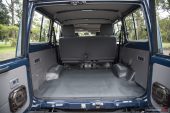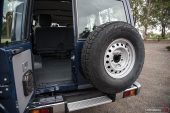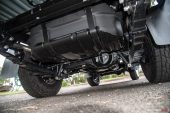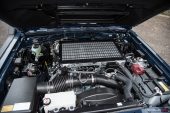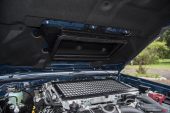Yes, you can still buy a Toyota LandCruiser 78 Series ‘Troop Carrier’ as a brand new vehicle in Australia. What’s the point of it? Well, say you’re looking for a vehicle that can take you and many of your things around Australia. To every corner. There aren’t many vehicles currently on the new-car market that offer the sheer dependability, off-road capability, and in-car space of the Troopy. Then again, there aren’t many vehicles that have been as extensively tested right here in Australia in our rugged conditions as the 70 Series, either. You could almost say it has been specifically designed to do such a job.
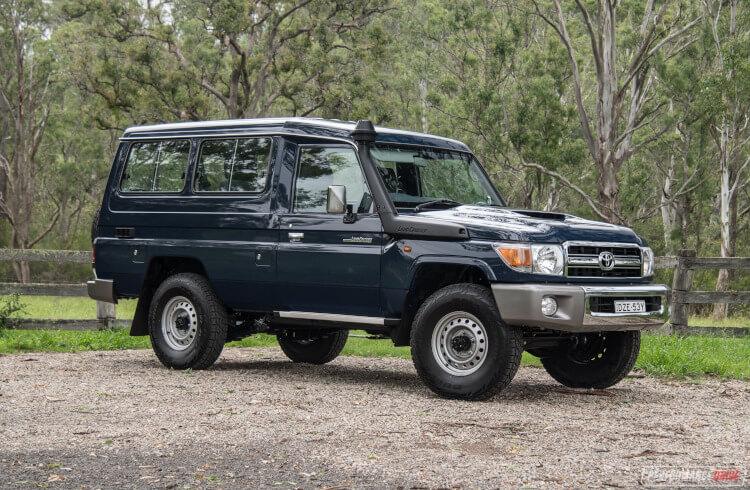
Toyota Australia gave the 70 Series an update in 2016-2017, bringing in revisions to the five-speed manual transmission so it cruises more smoothly on the highway, while revising the 4.5-litre turbo-diesel V8 to increase its efficiency, lower its noise, and improve its response and performance. Since then the model has been selling as is with no major change.
The 70 Series range, which includes single-cab and dual-cab chassis ute (79 Series), the wagon (76 Series), and Troop Carrier (78 Series), continue to be powered by the same engine, and all come equipped with a manual transmission and heavy-duty part-time four-wheel drive system. This beautiful Midnight Blue example you see here is the top-spec GXL Troop Carrier. Prices start at $70,740 for this, or from $67,640 for the base WorkMate variant.
[do_widget id=custom_html-9]
2019 Toyota LandCruiser 78 Series GXL Troop Carrier – THE SPECS
[column width=”47%” padding=”6%”]Engine: 4.5-litre turbo-diesel V8
Output: 151kW@3400rpm / 430Nm@1200-3200rpm
Transmission: Five-speed manual
Drive type: Part-time rear-wheel drive/four-wheel drive, front and rear lockers
Wheels: F & R: 16×6.0, 225/95
ANCAP: Unrated (ute versions 5 stars)
Tare weight: 2275kg
Power-to-weight: 15.06:1 (kg:kW)
Official fuel economy: 10.7L/100km
Economy during test: 11.4L/100km
Fuel capacity/Type: 180L/Diesel[/column] [column width=”47%” padding=”0″]Power efficiency: 14.11kW:L/100km
0-60km/h: 5.81 seconds*
0-100km/h: 13.14 seconds*
60-110km/h: 9.95 seconds*
1/8 mile: 12.25 seconds at 97.2km/h*
1/4 mile: 18.88 seconds at 121.8km/h*
Max acceleration: 0.702g
100-0km/h braking: 3.80 seconds at 48.83 metres*
Max deceleration: -1.053g
Decibel at idle: 60*
Peak decibel at 60-100km/h: 87*
Priced from: $70,740[/column][end_columns]
* Figures as tested by PerformanceDrive on the day. Factory claims may be different
2019 Toyota LandCruiser 78 Series GXL Troop Carrier – THE PACKAGE
Check out this interior. It’s laughably dated, and comes with hardly any luxuries or even conveniences. The step up to get in is really high, and even the side step is mounted right up close to the sill panel as to almost render it useless. But, despite these drawbacks, every time we get in we have a big smile on our face. It’s basically sticking its finger up to all of the new SUVs on the market that are so tailored to human beings, they almost become invisible and characterless.
As for the luxuries, the GXL does come with power windows with auto-up function for the driver. There’s also air-conditioning with adjustable settings for how hard you want the compressor to work. You also get an electric antenna which is a nice blast from the past. This is obviously not there so you can show off to your mates (although you will do anyway). It’s there so you can quickly lower it when you’re heading out into the bush. Aside from these features, that’s about it. Oh, there is a cup holder next to the gear lever and a mobile phone slot, with a few storage buckets down in between the front seats.
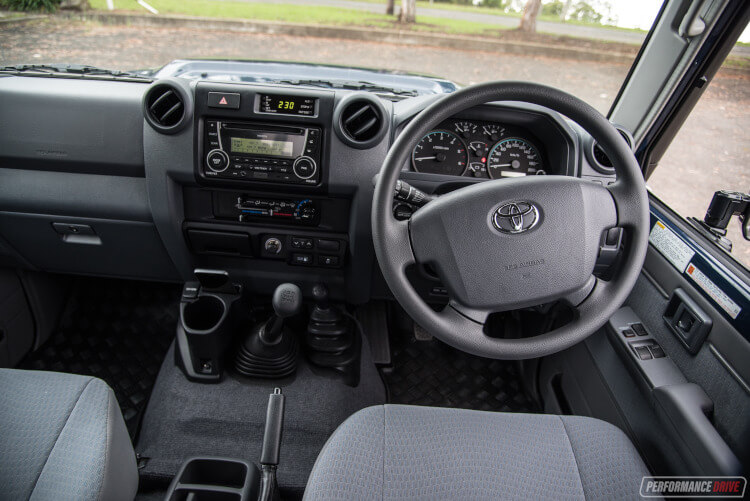
Being the Troop Carrier means there are only two side doors. So to access the rear bench seat you do need to go through the front, like a coupe. In that sense, it’s a bit like a ‘shooting brake’ body style – yep, a real trend-setter. Rear seat space is good, with enough legroom for adults and more than enough headroom. Width is a little bit narrow for three big adults to fit comfortably, but it is definitely doable. Unfortunately, safety isn’t really paramount, with just a lap belt for the middle seat.
If you need indoor cargo space the Troopy is ideal. The ceiling height and general boxy shape means the cargo area is huge, with a vinyl floor so you can easily slide in large objects and not worry about tearing carpet, or getting the floor dirty. For more space, the rear bench seat can be flipped right up and out of the way. And since the bench is old-school in design, with a simple frame and thin cushioning, it takes up minimal space when folded. You can also unbolt the thing altogether for van-like cargo-carrying ability.

Further than that, all models within the 70 Series range offer a towing capacity of 750kg, or braked towing capacity at the maximum allowed 3500kg for a passenger vehicle. For this Troop Carrier, the gross combination mass is 6800kg, including its 2325kg kerb weight (kerb weight includes full tank of fuel, tare weight includes only 10L of fuel). That means it is certified to tow 3500kg, and carry up to 975kg worth of cargo and passengers, including a full tank of fuel.
Not many vehicles on the market are able to match this. As an example, the Toyota HiLux SR5 manual dual-cab ute offers a towing capacity of 3500kg, but its kerb weight is 2040kg, and the gross combination mass is 5850kg. Added all up, this means it can technically only carry 310kg worth of passengers and cargo. Many of the dual-cab utes are a similar story.
2019 Toyota LandCruiser 78 Series GXL Troop Carrier – THE DRIVE
This is the best part about the vehicle. We found the driving experience to be really invigorating. Yes, the gear shift travel is huge and the steering play on centre has enough lock in it that would otherwise send a normal car off the road, but we love that it is interactive like this. You play a fundamental role in the driving. Having said that, there is cruise control so highway driving gives you a chance to relax and enjoy the view.
Speaking of which, the view is broad and clear. The tall windows and low window sills mean you can literally peer over other motorists like you’re on some kind of automotive porch (you just need the shotgun and rocking chair). On that note, there isn’t a great sense of privacy in the cabin. It’s not really a vehicle you could categorise as warm and cosy. Tinted windows would no doubt help, but the sheer size of the Troopy makes it very conspicuous.
As mentioned, Toyota Australia did make some minor but welcome adjustments to the powertrain a couple of years ago. Both second and fifth gears are taller, although first gear is still very short. This means it’s great for sudden inclines, but getting off the line at the traffic lights is immediately busy. Once you grab second gear, which is pretty much the second the wheels start rolling, it isn’t too bad. And then in fifth gear highway cruising requires a fairly modest 1900-2000rpm to maintain 100km/h.
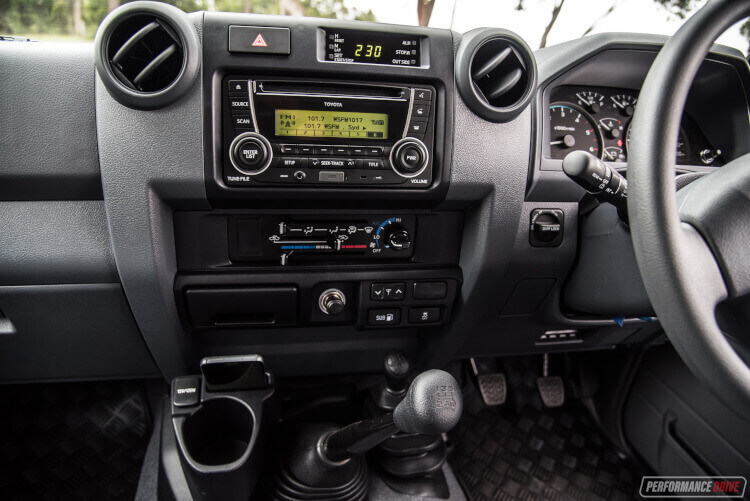
The engine also received some tuning, with the introduction of Piezo injectors. These were brought in for smoother revving and better response. Having driven the pre-updated version, we can confirm the latest tune is noticeably smoother and feels more powerful. It’s still a very rough engine, often feeling like it’s running on seven or even five cylinders, but it is much improved from before. Power peaks at 151kW and is achieved at 3400rpm, while torque peaks at 430Nm and is available between 1200rpm and 3200rpm. These outputs are unchanged from the pre-updated version.
On paper, the figures look pretty ordinary, especially for a 4.5L V8. However, it doesn’t feel like it lacks power or torque behind the wheel. We guess a lot of this comes from the lack of refinement. The rattly rear barn doors and the wind noise as it hits the square front end and smacks into the flat windscreen makes it feel like you’re flying along. Again, we actually really enjoy this. We know it’s a stupid thing to say but it somehow makes you feel alive.
Across the 0-100km/h sprint we pulled a best time of 13.14 seconds. This is quicker than what we achieved in the updated-spec 76 Series GXL wagon in 2017, which did 13.81, and a lot quicker than the pre-updated GXL 79 Series single-cab we tested in 2016, which did 14.85. So it seems although the outputs aren’t increased, the changes to the injectors and gears – and a larger bonnet scoop – have helped to improve performance.
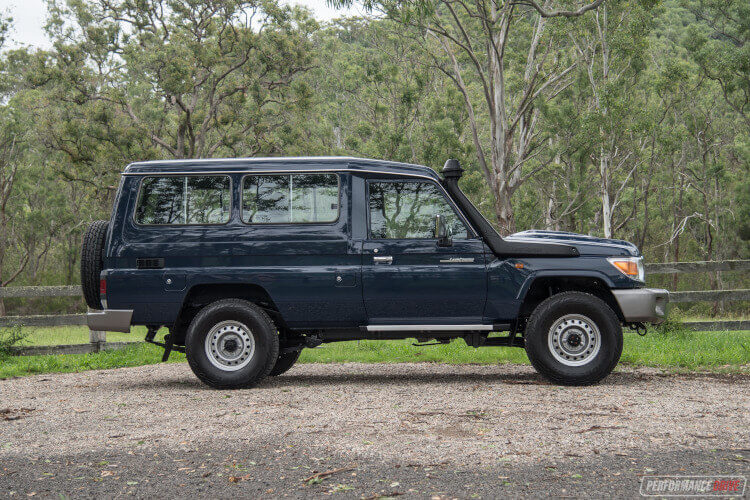
Shifting the tall gear lever requires a long throw, but it’s nice and solid, and you’ll never miss-shift due to the sheer action required to reach each slot. Despite it’s heavy-duty character the clutch pedal isn’t all that heavy, and the grab point is very clearly communicated. Steering feel is also very mechanical, obviously; there’s no electro setup here. It features a hydraulic, mechanical recirculating ball and nut setup. Toyota has made some revisions to it for the updated-spec model to improve feel. There’s still a huge amount of play on-centre, which we’re guessing has a lot to do with the tall, 95-section tyres. We’re also guessing the play might be there on purpose to help with off-roading. Sensitive steering isn’t ideal in rugged conditions, particularly when you’re travelling over endless corrugations.
In terms of long-distance capability, the GXL Troop Carrier comes with two 90-litre fuel tanks. At 180L in total, the fuel costs can be very high if you drain both tanks. But considering the official average consumption of 10.7L/100km, it means it does offer a theoretical average range of 1682km. This could be enough to get you from one end of the state to the other. Or, from one end of your farm to the other.
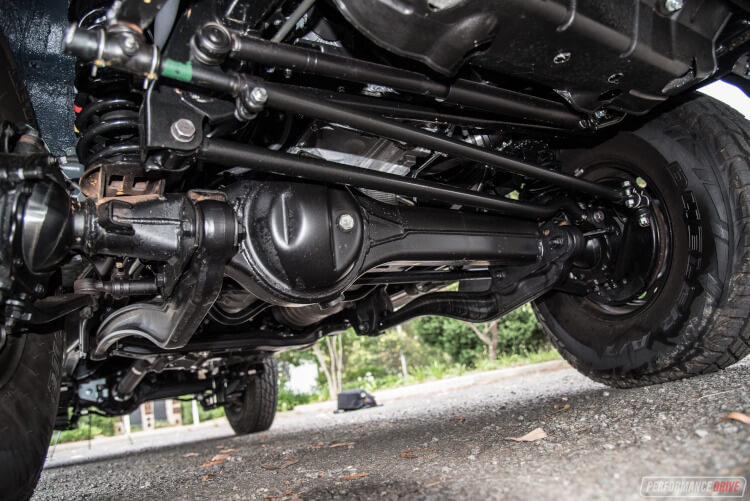
Off-road is obviously where this thing was born to live. It’s designed to conquer Australian conditions. In fact, Toyota engineers conducted over 100,000km in local testing for the 70 Series, and 70 per cent of that was off road. So as you can imagine, the performance in the rough stuff is about as good as it gets for a new passenger vehicle. As standard the GXL comes with front and rear differential locks which can be activated at the twist of a knob. There’s also auto-locking hubs now (with a manual option still available at the wheel hub), so you no longer have to exit the cabin to engage four-wheel drive.
With a 35-degree approach angle and a 25-degree departure angle, and a water wading depth of 700mm, the 78 Series is almost unstoppable in the bush. In our opinion the only main restriction is simply the bodywork. The platform, with both lockers engaged, will forge through any sort of reasonably-maintained track. Even if you want to venture off course, the body is the first thing that will slow you down. And we don’t mean the body hangs too low. We simply mean the platform and driveline will barge its way through anything.
There is a distinct feeling of uneasiness when clambering over sudden mounds or when traversing along heavily-angled tracks. It feels like it wants to roll over. We’re not saying it will (well, it might if you push hard enough). You just get this sense in your gut that it is a top-heavy car that wants to roll.
During our testing the LandCruiser pulled through everything we threw at it. This is, in our opinion, the best off-road vehicle on the new car market for under $100,000. We haven’t tested it but we assume the Mercedes-Benz G-Class offers similar prowess off road, but it is priced much higher than this.
2019 Toyota LandCruiser 78 Series GXL Troop Carrier – THE VIDEOS
2019 Toyota LandCruiser 78 Series GXL Troop Carrier – THE VERDICT
We love the 70 Series. It is such an engaging and fun vehicle to drive, purely because it is so retro and charming. It’s also very interactive, which is refreshing in a world that’s quickly becoming autonomous and almost monotonous. Being purely objective though, the 78 Series is crude, slow, under-featured, expensive, and obviously very dated and unsafe in comparison to the current market standards for SUVs. But we don’t give a shit. We want one more than we want our next breath. We’ll take the 76 wagon please, in GXL form with these steel wheels and tall tyres.
[column width=”47%” padding=”6%”]PROS:
– Outstanding off-road performance
– Interactive, charming drive character
– Robust powertrain
– Enormous cargo area in Troopy form
– Visibility
– Real towing capacity with high gross combination mass
– Retro, no other car like it
[/column] [column width=”47%” padding=”0″]CONS:
– Slow
– Lacks modern safety tech
– Crude interior
– Noisy compared with modern SUVs/utes
– Expensive
– No child seat anchors[/column][end_columns]
As always, if you’re thinking about buying a new car don’t forget to click here to speak with our car buying specialists.
[do_widget id=custom_html-14]
